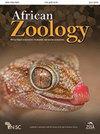得克萨斯州西部迁地种群中雄性达玛瞪羚Nanger Dama的家园范围大小
IF 0.5
4区 生物学
Q4 ZOOLOGY
引用次数: 1
摘要
Dama瞪羚(Nanger Dama Pallas, 1766)在非洲北部萨赫勒-撒哈拉地区的原生栖息地处于极度濒危状态。然而,德克萨斯州的几个牧场维持着种群数量,为防止灭绝提供了对冲,并可以为保护项目提供合适的种群,包括重新引入。对于这些举措,迫切需要关于雄性瞪羚空间需求的信息。尤其如此,因为在有限的区域内,雄性的攻击性行为阻碍了人口的增长。成年雄性会杀死其他雄性。本文报道了生活在美国西德克萨斯州8 996 ha的围栏牧场上的雄性东部大瞪羚(N. dama ruficollis)的空间分布和相互作用潜力(动物间距离)。我们为5名男性安装了gps无线电项圈,并在一年中每3小时跟踪他们的位置。成年雄性(n = 3)每年保持95%的核心家园面积(KHR),平均为1 783公顷,50%的核心面积平均为440公顷。成年人与邻近家庭范围之间的平均距离为2.8至4.6公里,仅记录了20米内的4次接触。亚成年雄性(n = 2)的活动范围更分散,有一个共同的核心区。他们只是在一段时间里在一个松散的单身团体里交往。它们使用的空间可能与成年雄性重叠。当满足空间要求时,由侵略引起的问题可以最小化。样本量小,无法提出明确的建议,但结果指出了进一步研究的有效途径,以加强对其他迁地种群的管理。本文章由计算机程序翻译,如有差异,请以英文原文为准。
Home Range Size of Male Dama Gazelles, Nanger dama, in an ex situ Population in West Texas
Dama gazelles (Nanger dama Pallas, 1766) are critically endangered within their native habitat of northern Africa's Sahelo-Saharan Zone. However, several Texas ranches maintain populations that provide a hedge against extinction and that can provide suitable stock for conservation projects, including reintroduction. For these initiatives, there is a critical need for information on spatial requirements of male dama gazelles. This is especially the case, because population increase is hindered by aggressive behaviour of males kept within limited areas. Adult males kill other males. We report on the spatial distribution and interaction potential (interanimal distances) of male eastern dama gazelles (N. dama ruficollis) from a population living on 8 996 ha of fenced rangeland in West Texas, USA. We fitted five males with GPS-radio collars and tracked their positions every 3 h for one year. Adult males (n = 3) maintained annual 95% Kernel Home Ranges (KHR) averaging 1 783 ha with 50% core areas averaging 440 ha. Average distance between adults with adjacent home ranges was 2.8 to 4.6 km, with only four contacts within 20 m recorded. Subadult males (n = 2) had more diffuse home ranges and a common core area. They only associated in a loose bachelor group for part of the time. Their space use can overlap with that of adult males. When spatial requirements are met, problems caused by aggression can be minimised. Small sample size prevents definite recommendations, but results point to productive avenues for additional study to enhance management of other ex situ populations.
求助全文
通过发布文献求助,成功后即可免费获取论文全文。
去求助
来源期刊

African Zoology
生物-动物学
CiteScore
2.60
自引率
9.10%
发文量
18
审稿时长
>12 weeks
期刊介绍:
African Zoology , a peer-reviewed research journal, publishes original scientific contributions and critical reviews that focus principally on African fauna in terrestrial, freshwater, and marine ecosystems. Research from other regions that advances practical and theoretical aspects of zoology will be considered. Rigorous question-driven research in all aspects of zoology will take precedence over descriptive research. The Journal publishes full-length papers, critical reviews, short communications, letters to the editors as well as book reviews. Contributions based on purely observational, descriptive or anecdotal data will not be considered.
The Journal is produced by NISC in association with the Zoological Society of South Africa (ZSSA). Acceptance of papers is the responsibility of the Editors-in-Chief in consultation with the Editors and members of the Editorial Advisory Board. All views expressed are those of the author and not necessarily those of the Editors or the Department.
 求助内容:
求助内容: 应助结果提醒方式:
应助结果提醒方式:


